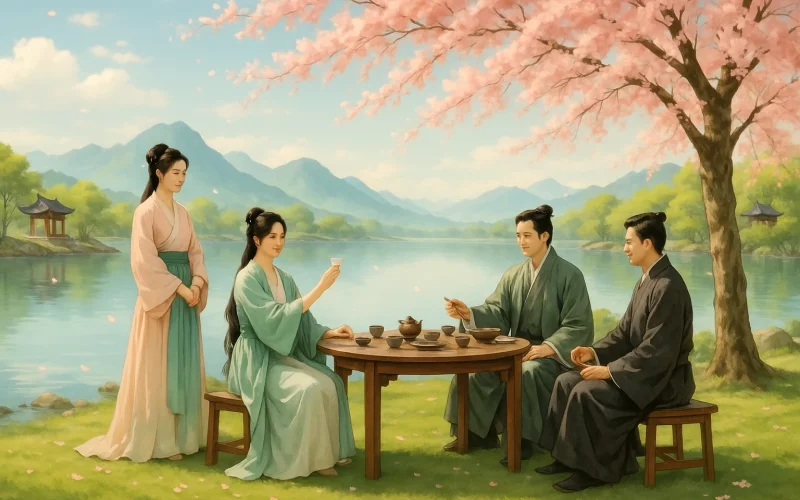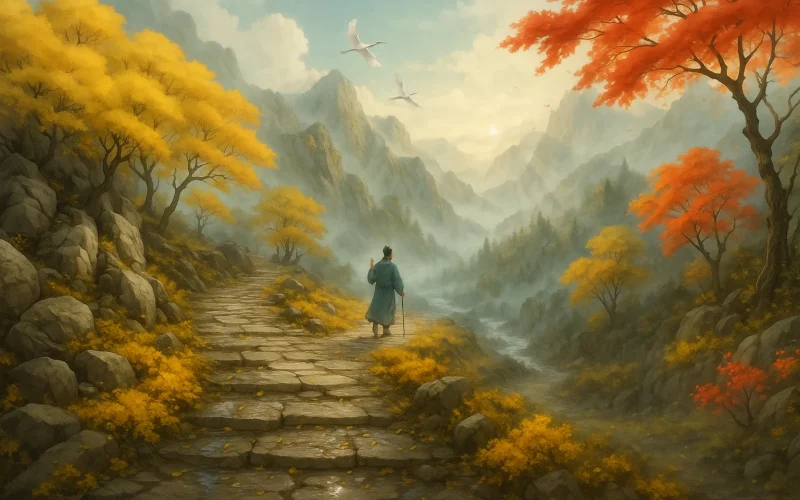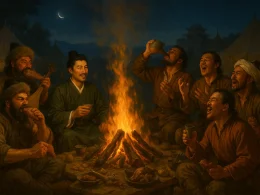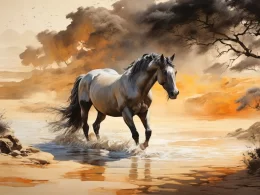The sunlit islet knows no bounds—
Each tree and pool holds a world of spring.
Fragrant grasses tug the reins of those who'd leave,
Red cherries are tossed in jest at dancing friends.
Blossoms drift down, drinking with the breeze,
While orioles sing freshly beyond the woods.
We’ve spent the whole day hand in hand—
What fate allowed this moment to be?
Original Poem
「宴伊东岸」
李端
晴洲无远近,一树一潭春。
芳草留归骑,朱樱掷舞人。
空花对酒落,小翠隔林新。
竟日皆携手,何由遇此辰。
Interpretation
Composed during a late spring gathering in the Tang Dynasty, this poem likely captures Li Duan's festive excursion with friends along the eastern banks of the Yi River (modern-day Luoyang, Henan). Such spring outings—feasting, strolling, and reveling in nature's renewal—epitomized the lyrical rhythms of Tang literati life. Through vivid snapshots of merriment, the poet celebrates seasonal beauty while mourning its inevitable passing, weaving joy and transience into a single silk of verse.
First Couplet: "晴洲无远近,一树一潭春。"
Qíng zhōu wú yuǎnjìn, yī shù yī tán chūn.
Sunlit isles erase the horizon—
Every tree, every pool breathes spring.
The opening dissolves spatial boundaries: "erased horizons" (无远近) stretch the scene into infinity, while each element—arboreal and aquatic—becomes a vessel of the season's essence. The couplet paints spring as both panorama and intimate detail, a world where distance collapses into presence.
Second Couplet: "芳草留归骑,朱樱掷舞人。"
Fāng cǎo liú guī qí, zhū yīng zhì wǔ rén.
Fragrant grasses clutch at homebound hooves;
Crimson cherries arc toward dancing figures.
Here, nature and revelry intertwine. The personified grasses (留归骑) plead for lingering, while flying cherries (朱樱掷) trace the laughter of companionship. This kinetic tableaux—where flora and festivity mirror each other—embodies spring's ephemeral, intoxicating spirit.
Third Couplet: "空花对酒落,小翠隔林新。"
Kōng huā duì jiǔ luò, xiǎo cuì gé lín xīn.
Blossoms drift like wine-poured snow;
Kingfishers flute through newborn groves.
Sensory delights crescendo: falling petals (空花落) mirror the pour of libations, merging human and natural offerings. The kingfisher's call (小翠), sharp and emerald-bright, stitches the scene with auditory jewels—a reminder that spring's magic thrives just beyond sight.
Fourth Couplet: "竟日皆携手,何由遇此辰。"
Jìng rì jiē xiéshǒu, hé yóu yù cǐ chén.
All day our clasped hands spoke—
When will such grace hours glow again?
The finale aches with anticipatory nostalgia. "Clasped hands" (携手) become hieroglyphs of connection, while the rhetorical question (何由) acknowledges time's cruel alchemy: even paradise, once named, becomes memory.
Holistic Appreciation
"Banquet on the Eastern Shore" is a quintessential Tang Dynasty spring banquet poem, characterized by its elegant language and seamless fusion of scene and sentiment. The poem begins with natural imagery, gradually shifts to human activity, and culminates in reflections on life's fleeting moments—a tightly structured progression that unfolds with deliberate grace.
With an ethereal touch, the poet captures the radiant spring scenery along the Yi River's eastern bank. The opening couplet paints nature's beauty, the second depicts human interaction with the landscape, and the third blends movement and stillness—showcasing both the charm of flowers and birds and the convivial atmosphere of drinking amid nature. The final couplet articulates the poet's innermost thoughts, elevating the theme to emphasize the preciousness of the present and the melancholy of impermanence. Particularly moving is the poet's attention to detail and emotional infusion. The line "fragrant grass detains returning steeds" ostensibly describes scenery but subtly conveys reluctance to part; "how can we encounter such moments again?" deepens the sigh of farewell. While the poem brims with sunlight and lyricism, beneath its surface joy lies a meditation on life's brevity and the transience of golden hours.
Artistic Merits
The poem's defining feature is its use of scenery to amplify emotion, masterfully balancing movement and stillness. Though the natural depictions are simple, each image carries the poet's emotional imprint. From the lively scene of "scarlet cherries tossed to dancers" to the serene beauty of "petals fall by our wine" and the delicate highlight of "emerald hues freshen beyond the woods," the poem reveals the poet's keen observation and expressive power. Linguistically, it is fresh and unadorned, echoing the folk-song quality of yuefu poetry. With minimal allusion, it prioritizes direct emotional expression, achieving a natural blend of scene and feeling reminiscent of Wang Wei and Meng Haoran's styles.
Insights
Life, like springtime, passes swiftly—scenery and gatherings fade in an instant, yet the joy found in nature and friendship becomes life's most cherished memory. The poet contrasts "hand in hand all day" with "how can we encounter such moments again?", teaching us to glimpse eternity within the ephemeral. This passion for the present and poignancy of parting transcend time, resonating deeply even today.
About the Poet
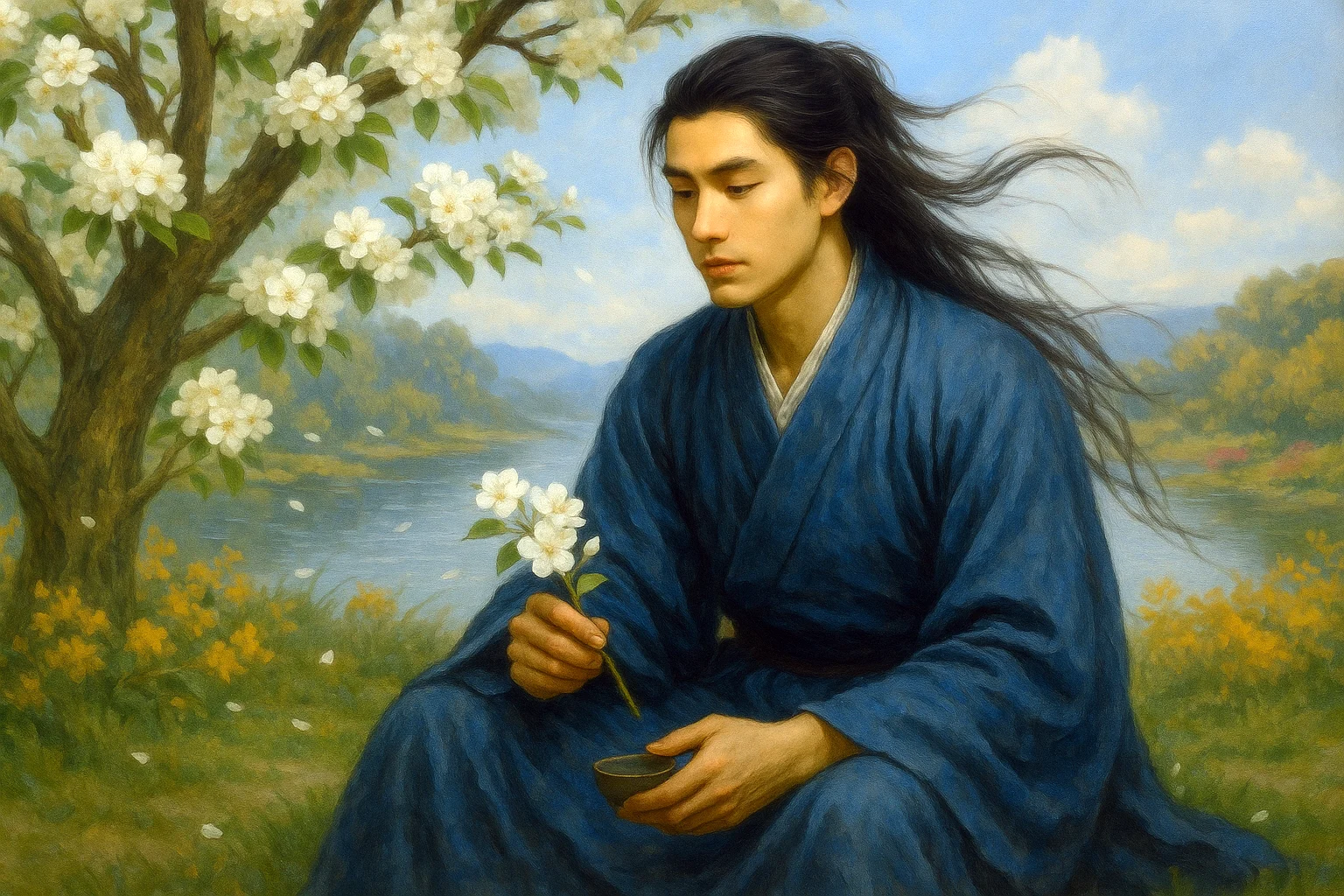
Li Duan (李端, c. 743–785), a native of Zhaoxian in Hebei Province, was among the "Ten Literary Talents of the Dali Era" during the Mid-Tang period. He excelled particularly in five-character regulated verse, crafting poetry of refined elegance and subtle nuance. His works frequently explored themes of reclusive living and the melancholy of separation, with over 250 poems preserved in the Complete Tang Poetry anthology.





